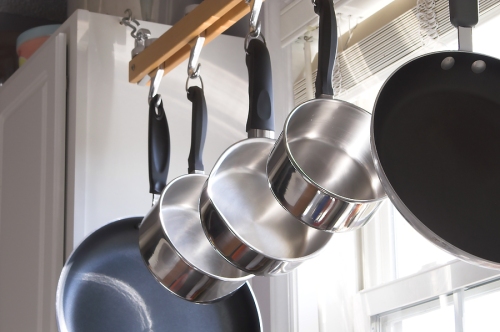What utensils does one need to cook Indian food at home?

Just the basics really. There are no fancy schmancy gadgets in my kitchen (confession at the end of the post). Nope, I don’t even have a pressure cooker, much less an idli maker or coconut grater (though I wish I had one of these). Now before you judge me, I need to share my philosophy about utensils.
You see, I think it’s a waste of money to have many gadgets that do only one thing. How many times do you actually use a strawberry slicer? Or the asparagus steamer? Ha, I thought so! And besides, all these gadgets take up too much space in the kitchen. I’d rather stock up on yet more spices. Some of my utensils need replacing (I bought them in a hurry while on a graduate student’s budget) especially since I cook a LOT now.
But getting back to the original question, you really just need a few utensils. Here’s what I use often, and not just for Indian food:
1. Japanese steel knife that is so sharp I was nervous about cutting off my fingers at first. It so effortlessly slices the juiciest of tomatoes that I was hooked. I use plastic cutting boards that are gentle on the knife and can be stuck in the dishwasher.
2. Mortar and pestle. I use it for all kinds of spices and grind them up just before using. I also use it to crush garlic and ginger and rock salt. Pounding away with the mortar is also great for some stress relief at the end of a long day!
3. Cast iron wok that I use not only for stir fries but also for stewing, braising, and frying, in and will still be using it twenty years from now. Learn how to season it properly, and it will be ‘non-stick’ to a large extent.
4. Small/medium/large pots with lids. I use stainless steel but am considering replacing at least one with heavy-duty aluminum for more even heat distribution and better conduction. Heating water in these pots takes forever to boil now. Perhaps it is because the pots can see I’m watching and everyone knows watching water boil slows it down. Or because I’m impatient and hungry. Seriously though, I’m tired of the hot spots in my stainless steel pots.
5. Two 12 inch skillets. I have teflon coated non-stick skillets currently but the coating is starting to wear off and it is time to replace them. I was torn between buying an All Clad non-stick or a cast iron skillet but considering that cast iron skillets are too heavy for my tiny wrists and non-sticks can’t take high heat, decided that more research was in order. Kitchen Emporium has a very useful list of the different materials used in cookware, their advantages and disadvantages. Overstock also has an excellent buying guide. And here’s a list of cookware brands that can washed in a dishwasher. Check out the links for details. I’ve summarized some of the information below:
Stainless Steel
Pros: light, dishwasher safe
Cons: un-even distribution of heat, poor heat conductor
Aluminum
Pros: good heat conductor
Cons: gets scratched easily, can stain easily when cleaned in the dishwasher
Cast Iron
Pros: distributes heat evenly, retains heat well, great for frying, browning and baking
Cons: heavy, need to season, not entirely non-stick even with seasoning (dosas can be difficult to make on a cast iron skillet)
Non-Stick
Pros: easy to clean, less oil/fat needed for cooking , great for making dosas!
Cons: coating wears off over time, need to take care to not scratch the surface
So, having digested all this information, what skillets are best for Indian food?
I would recommend a couple of different kinds to match a broad set needs. I’ll be getting a good quality 10 inch non-stick for Indian breads such as chapatis and rotis and my favorite dosas. And the 12 inch All Clad stainless steel skillet with an aluminum core will be my go-to skillet otherwise, especially for sautéing and making curries in.
Update 1/25/2011: I highly prefer my cast iron wok to make curries and even for sauteing. The All Clad is nice but I really have to be careful to keep the heat to medium or low. If you do get an All Clad, splurge for the 7 layer skillet. Otherwise count on needing to scrub off brown marks each time.
On a different note, I also tried an anodized aluminum skillet from Calphalon. I do *not* recommend this at all. Perhaps I’m using it incorrectly but this skillet has not been useful for cooking anything much less Indian food. Pancakes stick even with heat set to low. And the skillet is not easy to keep clean. There is sticky residue even after several washes.
Having lectured y’all on multi-use utensils, I do have a confession to make. Every rule has its exception, right!? There is something in my kitchen that only gets used a few times a year. A lovely fondue set that was a gift from my mother-in-law. We do use it for meat fondue, cheese fondue, and chocolate fondue. As for why it only gets used a couple times a year, I’ll blame that on my husband who is the fondue expert!


Agreed, Veena — those Japanese santokus can be quite scary if you’re not careful!
This is an excellent crash course in setting up a practical kitchen for a full range of cooking activities. Thanks for the tips!!
You are welcome! Glad it was useful